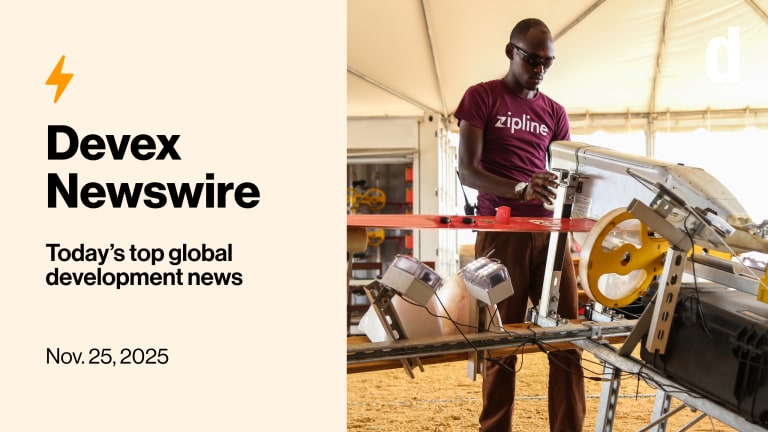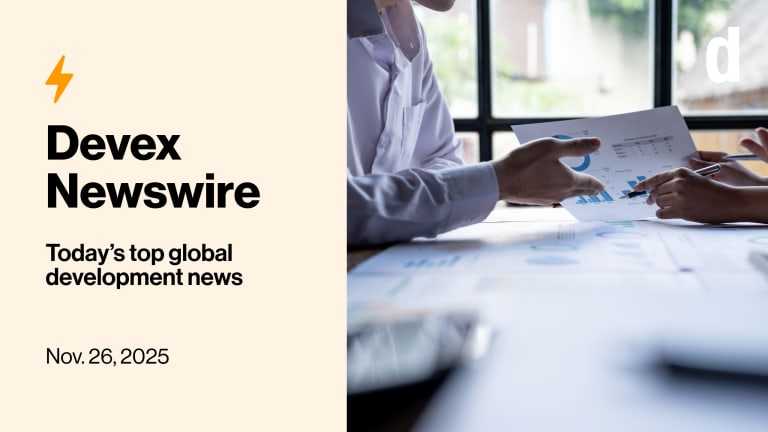Presented by International Monetary Fund

“Trade, not aid” is not a novel concept. Both donors and recipients have been saying it for years. Now, U.S. President Donald Trump is taking a stab at delivering it.
Also in today’s edition: Keeping the lights on, staff paid, and programs alive on a shoestring budget.
This is a preview of Newswire
Sign up to this newsletter for an inside look at the biggest stories in global development, in your inbox daily.
+ Philanthropic networks are taking on strategic roles, from shaping funding to advancing localization. A Devex Pro Funding briefing tomorrow, May 27, explores how these networks drive collective action, unlock capital, and impact the funding ecosystem. Save your spot now.
Either or
Trump’s critics say the president has sidelined — and even slandered — Africa. Perhaps then, his administration’s new “trade, not aid” approach to Africa is a hopeful sign that an entire continent is finally getting its due. But is it the right approach — or just one-sided, transactional dealmaking?
The strategy came into sharp relief during a visit this month by Troy Fitrell, the State Department’s top Africa official, to Côte d’Ivoire. There, he unveiled a new six-point plan focused on economic reforms and infrastructure projects aimed at creating market opportunities for American companies, my colleague Ayenat Mersie writes. Among the points:
• Prioritize commercial diplomacy by making it a core responsibility of U.S. ambassadors across Africa, who are now being “evaluated” based on their dealmaking success.
• Support market reforms in coordination with African governments. Countries that implement these reforms will be highlighted as prime destinations for U.S. investment.
• Advance high-impact infrastructure projects that unlock economic growth and attract private capital. This point also included a dig at “vanity projects or infrastructure built by the Chinese government.”
While the notion of advancing commercial diplomacy earned some plaudits, there’s a pesky sticking point: The administration has laid waste to the institutions that fostered economic development — think Millennium Challenge Corporation and USAID — while slapping tariffs on the world.
“You’re cutting aid, you’re dismantling programs, you’re bullying people on tariffs, but yet, then, you’re going to say, ‘Oh, welcome American business, and welcome American business on preferential terms,’ right?” says Jendayi Frazer, former U.S. assistant secretary of state for African affairs under President George W. Bush.
She also questioned why it has to be “trade, not aid.” Can’t it be both?
“I think it’s a false dichotomy,” Frazer says. “I’m fine with the signal — essentially that we need to look at more commercial and more private sector-oriented approaches to development.” But boosting economies cannot be divorced from ensuring the health and well-being of societies, she warns.
Read more: Inside the United States’ new ‘trade, not aid’ strategy in Africa (Pro)
+ Start your 15-day free Devex Pro trial today and gain immediate access to in-depth analyses, insider intelligence, crucial funding data, exclusive event access, and much more.
Will it blend?
Whether Trump’s “trade, not aid” strategy can succeed where similar efforts have struggled remains to be seen, but one thing is certain in this time of shriveling aid: The private sector is going to be a key player — at least, that’s the hope.
One approach to drumming up private dollars is blended finance, which leverages catalytic capital from public or philanthropic sources to boost private sector investment. But like “trade, not aid,” blended finance is not a new concept, and it remains a small slice of the development pie.
What’s worse, it could get smaller.
Battered aid budgets will likely mean a dip in blended finance over the next year or two, warns Joan Larrea, CEO of Convergence. Donors are being forced to make tough calls about how to make the most of dwindling budgets. The problem is compounded by the fact that before it was dismantled, USAID was the top donor agency supporting blended finance.
Still, even as U.S. support wanes, other donors are stepping up, including nontraditional ones such as the United Arab Emirates and Japan. There are also signs of increased efficiency in the use of concessional capital, or aid dollars used to bolster blended finance.
And, as my colleague Adva Saldinger writes, the same budgetary pressures squeezing traditional foreign aid could make blended finance more attractive, since it can stretch limited resources further by mobilizing additional capital.
Read: Blended finance shrinks slightly in 2024, but aid cuts cloud its future
Blend over backwards
Speaking of blended financing, Gavi, the Vaccine Alliance and the Asian Infrastructure Investment Bank are teaming up for the first time to strengthen health infrastructure and immunization programs in other countries — including in nations preparing to transition out of Gavi support.
Under the partnership, Gavi will blend its grant resources with AIIB loans. “A trailblazing partnership is the right way to describe that, because I think global health has sometimes lagged behind other areas of development in how vertical organizations like Gavi work with horizontal organizations like [multilateral development banks],” David Kinder, Gavi’s director of development finance, tells my colleague Jenny Lei Ravelo.
“If we do that well, we really have the potential to kind of save millions more lives by doing this,” he adds. “And this is just one of the first of a number of partnerships we want to bring together.”
Read: Gavi eyes blended financing in new partnership with AIIB
WHO wants to be a millionaire
Everyone nowadays seems to be cash-strapped and looking underneath the couch cushions for some loose change.
In the case of the World Health Organization, it’s looking to its corporate reserves.
Member states recently allowed the agency to tap into those reserves to cover staff salaries and severance pay. It’s a last resort, but a needed one for the financially ailing world body. Without it, Jenny writes that WHO would be forced to make decisions on staffing based on their contract type — or worse, “could run the risk of insolvency.”
Read: Member states allow WHO to use reserves for salaries and severance
Swooping in
If donors like the United States are retreating, can philanthropy rise to rescue global health? That’s one of the questions we posed at last week’s World Health Assembly during our Devex CheckUp @ WHA78 summit.
Most experts we talked to agreed: It can’t. But that doesn’t mean philanthropy doesn’t have a role to play.
“We are going to see a dramatic reduction in development assistance for health. It’s unfortunate. It will have real consequences, and I don’t want any of us to minimize that,” Anil Soni, the chief executive officer of the WHO Foundation, said at one of our WHA panels. “Mitigating harm in the short term by keeping the lights on on the most critical programs, yes, philanthropy can help.”
Kieran Daly of the Gates Foundation and Manisha Bhinge of The Rockefeller Foundation agreed, highlighting philanthropy’s role in incorporating local voices and local governments in health programs, and ensuring countries have “skin in the game” before those programs get off the ground.
“Who are those voices that are representative?” Bhinge asked. “And how do we engage them early on in the right platforms to help countries decide their priorities, not our priorities?”
Read: Can philanthropy save global health?
+ A special edition newsletter, hitting your inbox tomorrow, will break down WHA’s key takeaways, vital resolutions, and what it all means for the future of health. Be the first to know — keep an eye on your inbox.
Helping back home, from afar
Countries taking control of their own health systems can sometimes mean looking outward for help — not to aid or philanthropy, but to one’s own diaspora.
Diaspora communities are a lifeblood for lower-income countries. Remittances from Africans abroad, for example, topped $90 billion in 2023, surpassing all forms of foreign aid and international investments, writes Fredros Okumu, a professor at the University of Glasgow, in an opinion piece for Devex.
But he argues there’s an even bigger, largely untapped pool of resources abroad: “the expertise of diaspora scientists, innovators, and investors who are quietly rewiring Africa’s research and health care landscape.”
“Beyond sending money for school fees, health care, food, clothes, housing, and more, the diaspora can return home, physically or virtually, to confront Africa’s most pressing challenges,” he writes.
He explains that these experts “can offer mentorship and facilitate knowledge transfer through formal exchanges, provide targeted funding to jump-start local innovation hubs, invest directly in building research labs or clinical trial facilities, or advocate internationally for more equitable inclusion of Africa in global research and development, or R&D, efforts.”
Opinion: Diaspora scientists are supercharging Africa’s health innovation
In other news
Jake Wood, the head of the Gaza Humanitarian Foundation, quit Sunday, ahead of the launch of its operations, citing inability to uphold humanitarian principles. [The New York Times]
Extreme weather events such as flooding and drought caused by the climate crisis have cost low-income countries $156 billion over the last two decades. [The Independent]
Fifteen trucks on their way to WFP-supported bakeries in Gaza were looted Thursday, a few days after Israel lifted its blockade. [ABC News]
Sign up to Newswire for an inside look at the biggest stories in global development.








